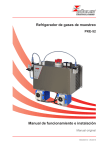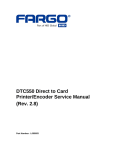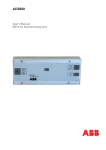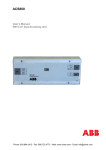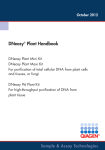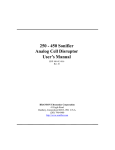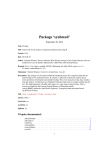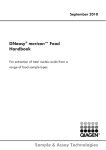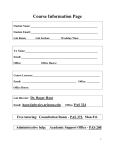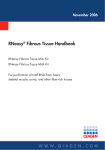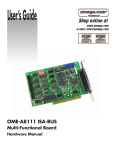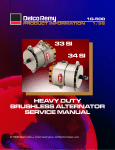Download Mag-Bind®Universal Pathogen 96 Kit - Omega Bio-Tek
Transcript
Mag-Bind® Universal Pathogen 96 Kit M4029-00 M4029-01 1 x 96 preps 4 x 96 preps August 2015 Mag-Bind® Universal Pathogen 96 Kit Table of Contents Introduction and Overview.......................................................................2 Kit Contents/Storage and Stability.........................................................3 Preparing Reagents......................................................................................4 Tissue Protocol...............................................................................................5 Serum/Stool Protocol..................................................................................9 Urine Protocol..............................................................................................13 Troubleshooting Guide............................................................................17 Manual Revision: August 2015 Innovations in nucleic acid isolation 1 Introduction and Overview Introduction The Mag-Bind® Universal Pathogen 96 Kit allows rapid and reliable isolation of highquality host genomic DNA, gram positive and negative bacterial DNA , fungal spore DNA, and viral DNA and viral RNA from tissue, urine, serum, and fecal samples. The system allows for automation after sample lysis via Hamilton STAR™, Thermo KingFisher™ Flex, Applied Biosystems® MagMAX™, Qiagen BioSprint, and other liquid handling instruments. The system combines the Mag-Bind® technology with RBB Buffer to eliminate PCR inhibiting compounds within the samples. Purified DNA is suitable for PCR, restriction digestion, and hybridization applications. There are no organic extractions thus reducing plastic waste and hands-on time and multiple samples can be processed in parallel. 2 Kit Contents Product Number M4029-00 M4029-01 1 x 96 preps 4 x 96 preps E-Z 96 Disruptor Plus Plates 1 4 Caps for Racked Microtubes 13 52 Mag-Bind® Particles RQ 2.2 mL 9 mL SLX-Mlus Buffer 60 mL 240 mL DS Buffer 8 mL 30 mL PCP Buffer 25 mL 100 mL XP2 Buffer 40 mL 160 mL RBB Buffer 40 mL 160 mL VHB Buffer 88 mL 3 x 88 mL SPM Wash Buffer 30 mL 4 x 30 mL Elution Buffer 15 mL 50 mL Proteinase K Solution 2.2 mL 9 mL 1 1 Purifications User Manual Storage and Stability All of the Mag-Bind® Universal Pathogen 96 Kit components are guaranteed for at least 12 months from the date of purchase when stored as follows. Mag-Bind® Particles RQ must be stored at 2-8°C. Proteinase K Solution can be stored at room temperature for up to 12 months. For long-term storage, store Proteinase K Solution at 2-8°C. All remaining components should be stored at room temperature. During shipment or storage in cool ambient conditions, precipitates may form in some of the buffers. Dissolve such deposits by warming the solution at 37°C and gently shaking. 3 Preparing Reagents 1. 2. 4 Dilute SPM Wash Buffer with 100% ethanol as follows and store at room temperature. Kit 100% Ethanol to be Added M4029-00 70 mL M4029-01 70 mL per bottle Dilute VHB Buffer with 100% ethanol follows and store at room temperature. Kit 100% Ethanol to be Added M4029-00 112 mL M4029-01 112 mL per bottle Mag-Bind® Universal Pathogen 96 Kit Tissue Protocol Mag-Bind® Universal Pathogen 96 Kit - Tissue Protocol Materials and Equipment to be Supplied by User: • • • • • • • • • Centrifuge capable of at least 3,500 x g with adaptor for 96-well plates Magnetic Separation Device (Recommend Cat# AlpAqua® 96M A000250) Incubator capable of 70°C 96-well plates with a capacity of at least 1.7 mL (Recommend Nunc 278752) and compatible with the Magnetic Separation Device 96-well microplates for DNA storage Vortexer 100% ethanol Nuclease-free water Optional: Mixer mill such as a SPEX CertiPrep Geno/Grinder® 2010 or Qiagen TissueLyser Before Starting: • • • Prepare VHB Buffer and SPM Wash Buffer according to the “Preparing Reagents” section on Page 4. Set an incubator to 70°C. Heat Elution Buffer to 70°C. 1. Briefly spin the E-Z 96 Disruptor Plus Plate to remove any glass beads from the walls of the wells. Uncap the E-Z 96 Disruptor Plus Plate and save the caps for use in Step 3. 2. Add 25-30 mg tissue to each well. 3. Add 525 µL SLX-Mlus Buffer to each sample. Seal the E-Z 96 Disruptor Plus Plate with the caps removed in Step 1. 4. Vortex at maximum speed for 3-5 minutes to lyse and homogenize samples. For best results, a Mixer Mill, such as Spex CertiPrep Geno/Grinder® 2010 or Qiagen Tissuelyser, should be used. Note: Depending on the sample amount and type, the amount of SLX-Mlus Buffer may need to be adjusted so that 300 µL can be recovered after Step 5. 5 Mag-Bind® Universal Pathogen 96 Kit Tissue Protocol 5. Centrifuge at 1,000-2,000 x g for 60 seconds at room temperature. 6. Remove and discard the caps from the E-Z 96 Disruptor Plus Plate. 7. Add 53µL DS Buffer and 20 µL Proteinase K Solution to each sample. 8. Seal the E-Z 96 Disruptor Plus Plate with new Caps for Racked Microtubes (provided). 9. Vortex for 60 seconds to mix thoroughly. 10. Incubate at 70°C for 15 minutes. Mix once during incubation. 11. Centrifuge at 3,500 x g for 10 minutes. 12. Transfer 300 µL cleared supernatant to a 96-well deep-well plate (1.7 mL) compatible with the Magnetic Separation Device used. Note: Do not transfer any debris as it can reduce yield and purity. 13. Add 300 µL XP2 Buffer, 300 µL RBB Buffer, and 20 µL Mag-Bind® Particles RQ to each sample. Vortex to mix thoroughly or pipet up and down 20 times. Note: Mag-Bind® Particles RQ and XP2 Buffer can be prepared as a mastermix prior to use. Prepare only what is needed. Tip mixing is recommended for automated protocols for best yield. 14. Let sit at room temperature for 10 minutes. 15. Place the 96-well deep-well plate on the Magnetic Separation Device to magnetize the Mag-Bind® Particles RQ. Let sit at room temperature until the Mag-Bind® Particles RQ are completely cleared from solution. 16. Aspirate and discard the cleared supernatant. Do not disturb the Mag-Bind® Particles RQ. 6 Mag-Bind® Universal Pathogen 96 Kit Tissue Protocol 17. Remove the plate containing the Mag-Bind® Particles RQ from the Magnetic Separation Device. 18. Add 600 µL VHB Buffer to each sample. Resuspend the Mag-Bind® Particles RQ by vortexing or pipetting up and down 20 times. Note: VHB Buffer must be diluted with 100% ethanol prior to use. Please see Page 4 for instructions. 19. Let sit at room temperature for 2 minutes. 20. Place the 96-well deep-well plate on the Magnetic Separation Device to magnetize the Mag-Bind® Particles RQ. Let sit at room temperature until the Mag-Bind® Particles RQ are completely cleared from solution. 21. Aspirate and discard the cleared supernatant. Do not disturb the Mag-Bind® Particles RQ. 22. Remove the plate containing the Mag-Bind® Particles RQ from the Magnetic Separation Device. 23. Repeat Steps 18-22 once for a second VHB Wash step. 24. Add 600 µL SPM Wash Buffer to each sample. Resuspend the Mag-Bind® Particles RQ by vortexing or pipetting up and down 20 times. Note: SPM Wash Buffer must be diluted with 100% ethanol prior to use. Please see Page 4 for instructions. 25. Let sit at room temperature for 2 minutes. 26. Place the 96-well plate on the Magnetic Separation Device to magnetize the MagBind® Particles RQ. Let sit at room temperature until the Mag-Bind® Particles RQ are completely cleared from solution. 27. Aspirate and discard the cleared supernatant. Do not disturb the Mag-Bind® Particles RQ. 7 Mag-Bind® Universal Pathogen 96 Kit Tissue Protocol 28. Leave the plate on the Magnetic Separation Device. 29. Add 500 µL nuclease-free water (not provided) to each sample. Immediately aspirate the nuclease free water. Do not let the samples stay in contact with the nuclease-free water for more than 60 seconds. Note: If using an automated platform, use the maximum volume the tips will allow up to 600 µL. 30. Add 50-100 μL Elution Buffer heated to 70°C to each sample. Resuspend the MagBind® Particles RQ by vortexing or pipetting up and down 20 times. 31. Let sit at room temperature for 5 minutes. 32. Place the 96-well plate on the Magnetic Separation Device to magnetize the MagBind® Particles RQ. Let sit at room temperature until the Mag-Bind® Particles RQ are completely cleared from solution. 33. Transfer the cleared supernatant containing purified DNA to a clean 96-well microplate. Store the DNA at -20°C. 8 Mag-Bind® Universal Pathogen 96 Kit Serum & Stool Protocol Mag-Bind® Universal Pathogen 96 Kit - Serum & Stool Protocol Materials and Equipment to be Supplied by User: • • • • • • • • • Centrifuge capable of at least 3,500 x g with adaptor for 96-well plates Magnetic Separation Device (Recommend Cat# AlpAqua® 96M A000250) Incubator capable of 70°C 96-well plates with a capacity of at least 1.7 mL (Recommend Nunc 278752) and compatible with the Magnetic Separation Device 96-well microplates for DNA storage Vortexer 100% ethanol Nuclease-free water Optional: Mixer mill such as a SPEX CertiPrep Geno/Grinder® 2010 or Qiagen TissueLyser Before Starting: • • • Prepare VHB Buffer and SPM Wash Buffer according to the “Preparing Reagents” section on Page 4. Set an incubator to 70°C. Heat Elution Buffer to 70°C. 1. Briefly spin the E-Z 96 Disruptor Plus Plate to remove any glass beads from the walls of the wells. Uncap the E-Z 96 Disruptor Plus Plate and save the caps for use in Step 3. 2. Add 250 µL serum or stool samples to each well. If stool sample is solid, resuspend to 10% wgt/volume in PBS before starting. 3. Add 275 µL SLX-Mlus Buffer to each sample. Seal the E-Z 96 Disruptor Plus Plate with the caps removed in Step 1. 4. Vortex at maximum speed for 3-5 minutes to lyse and homogenize samples. For best results, a Mixer Mill, such as Spex CertiPrep Geno/Grinder® 2010 or Qiagen Tissuelyser, should be used. Note: Depending on the sample amount and type, the amount of SLX-Mlus Buffer may need to be adjusted so that 300 µL can be recovered after Step 5. 9 Mag-Bind® Universal Pathogen 96 Kit Serum & Stool Protocol 5. Centrifuge at 1,000-2,000 x g for 60 seconds at room temperature. 6. Remove and discard the caps from the E-Z 96 Disruptor Plus Plate. 7. Add 50 µL DS Buffer and 20 µL Proteinase K Solution to each sample. 8. Seal the E-Z 96 Disruptor Plus Plate with new Caps for Racked Microtubes (provided). 9. Vortex for 60 seconds to mix thoroughly. 10. Incubate at 70°C for 15 minutes. Mix once during incubation. 11. Centrifuge at 3,500 x g for 10 minutes. 12. Transfer 300 µL cleared supernatant to a 96-well deep-well plate (1.7 mL) compatible with the Magnetic Separation Device used. Note: Do not transfer any debris as it can reduce yield and purity. 13. Add 300 µL XP2 Buffer, 300 µL RBB Buffer, and 20 µL Mag-Bind® Particles RQ to each sample. Vortex to mix thoroughly or pipet up and down 20 times. Note: Mag-Bind® Particles RQ and XP2 Buffer can be prepared as a mastermix prior to use. Prepare only what is needed. Tip mixing is recommended for automated protocols for best yield. 14. Let sit at room temperature for 10 minutes. 15. Place the 96-well deep-well plate on the Magnetic Separation Device to magnetize the Mag-Bind® Particles RQ. Let sit at room temperature until the Mag-Bind® Particles RQ are completely cleared from solution. 16. Aspirate and discard the cleared supernatant. Do not disturb the Mag-Bind® Particles RQ. 10 Mag-Bind® Universal Pathogen 96 Kit Serum & Stool Protocol 17. Remove the plate containing the Mag-Bind® Particles RQ from the Magnetic Separation Device. 18. Add 600 µL VHB Buffer to each sample. Resuspend the Mag-Bind® Particles RQ by vortexing or pipetting up and down 20 times. Note: VHB Buffer must be diluted with 100% ethanol prior to use. Please see Page 4 for instructions. 19. Let sit at room temperature for 2 minutes. 20. Place the 96-well deep-well plate on the Magnetic Separation Device to magnetize the Mag-Bind® Particles RQ. Let sit at room temperature until the Mag-Bind® Particles RQ are completely cleared from solution. 21. Aspirate and discard the cleared supernatant. Do not disturb the Mag-Bind® Particles RQ. 22. Remove the plate containing the Mag-Bind® Particles RQ from the Magnetic Separation Device. 23. Repeat Steps 18-22 once for a second VHB Wash step. 24. Add 600 µL SPM Wash Buffer to each sample. Resuspend the Mag-Bind® Particles RQ by vortexing or pipetting up and down 20 times. Note: SPM Wash Buffer must be diluted with 100% ethanol prior to use. Please see Page 4 for instructions. 25. Let sit at room temperature for 2 minutes. 26. Place the 96-well plate on the Magnetic Separation Device to magnetize the MagBind® Particles RQ. Let sit at room temperature until the Mag-Bind® Particles RQ are completely cleared from solution. 27. Aspirate and discard the cleared supernatant. Do not disturb the Mag-Bind® Particles RQ. 11 Mag-Bind® Universal Pathogen 96 Kit Serum & Stool Protocol 28. Leave the plate on the Magnetic Separation Device. 29. Add 500 µL nuclease-free water (not provided) to each sample. Immediately aspirate the nuclease free water. Do not let the samples stay in contact with the nuclease-free water for more than 60 seconds. Note: If using an automated platform, use the maximum volume the tips will allow up to 600 µL. 30. Add 50-100 μL Elution Buffer heated to 70°C to each sample. Resuspend the MagBind® Particles RQ by vortexing or pipetting up and down 20 times. 31. Let sit at room temperature for 5 minutes. 32. Place the 96-well plate on the Magnetic Separation Device to magnetize the MagBind® Particles RQ. Let sit at room temperature until the Mag-Bind® Particles RQ are completely cleared from solution. 33. Transfer the cleared supernatant containing purified DNA to a clean 96-well microplate. Store the DNA at -20°C. 12 Mag-Bind® Universal Pathogen 96 Kit Urine Protocol Mag-Bind® Universal Pathogen 96 Kit - Urine Protocol Materials and Equipment to be Supplied by User: • • • • • • • • • • Centrifuge capable of at least 3,500 x g with adaptor for 96-well plates Magnetic Separation Device (Recommend Cat# AlpAqua® 96M A000250) Incubator capable of 70°C 96-well plates with a capacity of at least 1.7 mL (Recommend Nunc 278752) and compatible with the Magnetic Separation Device 96-well microplates for DNA storage Vortexer 100% ethanol Nuclease-free water Optional: Mixer mill such as a SPEX CertiPrep Geno/Grinder® 2010 or Qiagen TissueLyser Ice Bucket Before Starting: • • • • Prepare VHB Buffer and SPM Wash Buffer according to the “Preparing Reagents” section on Page 4. Set an incubator to 70°C. Heat Elution Buffer to 70°C Prepare an ice Bucket 1. Briefly spin the E-Z 96 Disruptor Plus Plate to remove any glass beads from the walls of the wells. Uncap the E-Z 96 Disruptor Plus Plate and save the caps for use in Step 3. 2. Add 250 µL urine sample to each well. 3. Add 275 µL SLX-Mlus Buffer to each sample. Seal the E-Z 96 Disruptor Plus Plate with the caps removed in Step 1. 4. Vortex at maximum speed for 3-5 minutes to lyse and homogenize samples. For best results, a Mixer Mill, such as Spex CertiPrep Geno/Grinder® 2010 or Qiagen Tissuelyser, should be used. Note: Depending on the sample amount and type, the amount of SLX-Mlus Buffer may need to be adjusted so that 300 µL can be recovered after Step 5. 13 Mag-Bind® Universal Pathogen 96 Kit Urine Protocol 5. Centrifuge at 1,000-2,000 x g for 60 seconds at room temperature. 6. Remove and discard the caps from the E-Z 96 Disruptor Plus Plate. 7. Add 50 µL DS Buffer and 20 µL Proteinase K Solution to each sample. 8. Seal the E-Z 96 Disruptor Plus Plate with new Caps for Racked Microtubes (provided). 9. Vortex for 60 seconds to mix thoroughly. 10. Incubate at 70°C for 15 minutes. Mix once during incubation. 11. Add 200 µL PCP Buffer to each well. Place the plate on ice for 5 minutes. 12. Centrifuge at 3,500 x g for 10 minutes. 13. Transfer 300 µL cleared supernatant to a 96-well deep-well plate (1.2 mL) compatible with the Magnetic Separation Device used. Note: Do not transfer any debris as it can reduce yields and purity. 14. Add 300 µL XP2 Buffer, 300 µL RBB Buffer, and 20 µL Mag-Bind® Particles RQ to each sample. Vortex to mix thoroughly or pipet up and down 20 times. Note: Mag-Bind® Particles RQ and XP2 Buffer can be prepared as a mastermix prior to use. Prepare only what is needed. Tip mixing is recommended for automated protocols for best yield. 15. Let sit at room temperature for 10 minutes. 16. Place the 96-well deep-well plate on the Magnetic Separation Device to magnetize the Mag-Bind® Particles RQ. Let sit at room temperature until the Mag-Bind® Particles RQ are completely cleared from solution. 14 Mag-Bind® Universal Pathogen 96 Kit Urine Protocol 17. Aspirate and discard the cleared supernatant. Do not disturb the Mag-Bind® Particles RQ. 18. Remove the plate containing the Mag-Bind® Particles RQ from the Magnetic Separation Device. 19. Add 600 µL VHB Buffer to each sample. Resuspend the Mag-Bind® Particles RQ by vortexing or pipetting up and down 20 times. Note: VHB Buffer must be diluted with 100% ethanol prior to use. Please see Page 4 for instructions. 20. Let sit at room temperature for 2 minutes. 21. Place the 96-well deep-well plate on the Magnetic Separation Device to magnetize the Mag-Bind® Particles RQ. Let sit at room temperature until the Mag-Bind® Particles RQ are completely cleared from solution. 22. Aspirate and discard the cleared supernatant. Do not disturb the Mag-Bind® Particles RQ. 23. Remove the plate containing the Mag-Bind® Particles RQ from the Magnetic Separation Device. 24. Repeat Steps 19-23 once for a second VHB Wash step. 25. Add 600 µL SPM Wash Buffer to each sample. Resuspend the Mag-Bind® Particles RQ by vortexing or pipetting up and down 20 times. Note: SPM Wash Buffer must be diluted with 100% ethanol prior to use. Please see Page 4 for instructions. 26. Let sit at room temperature for 2 minutes. 15 Mag-Bind® Universal Pathogen 96 Kit Urine Protocol 27. Place the 96-well plate on the Magnetic Separation Device to magnetize the MagBind® Particles RQ. Let sit at room temperature until the Mag-Bind® Particles RQ are completely cleared from solution. 28. Aspirate and discard the cleared supernatant. Do not disturb the Mag-Bind® Particles RQ. 29. Leave the plate on the Magnetic Separation Device. 30. Add 500 µL nuclease-free water (not provided) to each sample. Immediately aspirate the nuclease free water. Do not let the samples stay in contact with the nuclease-free water for more than 60 seconds. Note: If using an automated platform, use the maximum volume the tips will allow up to 600 µL. 31. Add 50-100 μL Elution Buffer heated to 70°C to each sample. Resuspend the MagBind® Particles RQ by vortexing or pipetting up and down 20 times. 32. Let sit at room temperature for 5 minutes. 33. Place the 96-well plate on the Magnetic Separation Device to magnetize the MagBind® Particles RQ. Let sit at room temperature until the Mag-Bind® Particles RQ are completely cleared from solution. 34. Transfer the cleared supernatant containing purified DNA to a clean 96-well microplate. Store the DNA at -20°C. 16 Troubleshooting Guide Please use this guide to troubleshoot any problems that may arise. For further assistance, please contact the technical support staff, toll free, at 1-800-832-8896. Problem Cause Solution • A260/A230 ratio is low A260/A280 ratio is high Low DNA Yield or no DNA Yield Problems in downstream applications Salt contamination • • Repeat the DNA isolation with a new sample. Extend the incubation time with VHB Buffer. Wash the Mag-Bind® Particles RQ with ethanol. RNA contamination The protocol does not remove RNA. If desired, add 5 µL RNase A (25 mg/mL) after lysate is cleared and before binding buffers are added. Let sit at room temperature for 5 minutes. Poor homogenization of sample Repeat the DNA isolation with a new sample, be sure to mix the sample with SLX-Mlus Buffer thoroughly. Use a commercial homogenizer if possible. DNA washed off Make sure VHB Buffer and SPM Wash Buffer are mixed with ethanol. Water Wash extended Make sure that water wash step does not exceed 60 seconds and the Mag-Bind® Particles RQ are not resuspended. Mag-Bind® Particles RQ lost in process After water is added during wash step Mag-Bind® Particles RQ will go into solution. Let magnetic beads remagnetize prior to aspirating liquid. BSA not added to PCR mixture Add BSA to a final concentration of 0.1 μg/mL to the PCR mixture. Too much DNA Dilute the DNA elute used in the downstream inhibits PCR reactions application if possible. Non-specific bands in Use hot-start Taq polymerase mixture. downstream PCR Problems in downstream applications Inhibitory substance in the eluted DNA. Check the A260/A230 ratio. Dilute the elute to 1:50 if necessary. 17






















